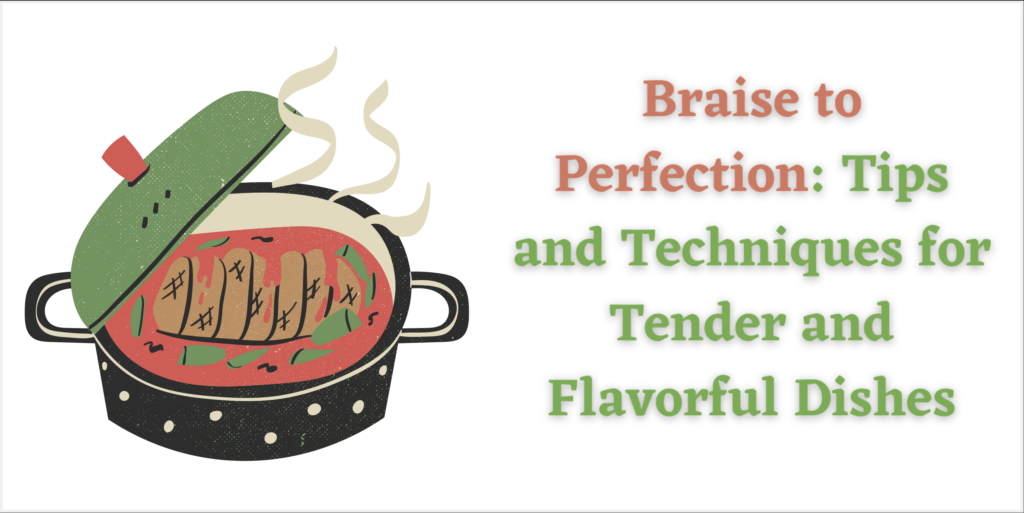Braising tips and techniques
Braising is a cooking method that involves searing meat or vegetables and then simmering them in a flavorful liquid until they become tender and flavorful. This method, employed for centuries, is still widely practised because it yields exceptionally flavorful and tender food.
In this post, we will explore some helpful tips and techniques for achieving tender and flavorful dishes through braising. We’ll cover everything from choosing the right cooking vessel to incorporating different liquids and seasonings to add depth of flavor. Whether you’re new to braising or a seasoned pro, our guide to braising tips and techniques will help you create mouth-watering meals that are sure to impress.
What is Braising?
Braising is a cooking technique where food is cooked slowly in a small amount of liquid, typically in a covered pot. This allows the food to cook evenly and absorb the liquid, resulting in a rich and flavorful dish. Braising is a great way to prepare tough cuts of meat as the low and slow cooking process breaks down the connective tissue, resulting in tender and juicy meat. Vegetables can also be braised and are a great accompaniment to meat.
Beef brisket, pork shoulder, and lamb shanks are popular meats for braising. Root vegetables such as carrots, potatoes, and parsnips are great options as they can withstand a long cooking time. Braising liquids can vary from broth to wine to tomato sauce, and each can add a unique flavor to the dish.
To achieve the best results when braising, it’s important to use a heavy-bottomed pot with a tight-fitting lid to ensure even heat distribution and prevent the liquid from evaporating. Searing the meat before braising helps to develop a rich flavor. It’s also important not to lift the lid too often, which can slow the cooking process by causing temperature fluctuations. By following these braising tips and techniques, you can create a delicious and tender dish that will leave your taste buds wanting more. What you eat is what you are.
Tips for Braising to Perfection
Firstly, it’s important to choose the right cooking vessel. A Dutch oven with a tight-fitting lid is an excellent choice as it retains heat and moisture, allowing the meat to cook evenly.
Next, sear the meat in oil until it’s browned all over. This adds flavor and helps to seal in the juices. Be sure to pat the meat dry with paper towels before searing it to achieve a good crust.
The amount of liquid you use is also crucial. Too much liquid can result in a watery sauce, while too little can cause the meat to dry out. Generally, you want enough liquid to cover the meat by about two-thirds.
Cook the meat at a low temperature, around 325°F, for several hours until it’s fork-tender. Remember to allow the meat to rest for a few minutes before serving. This helps to redistribute the juices and makes for a more flavorful and tender dish.
By following these Braising Tips and Techniques, you can create delicious and succulent braised dishes that impress you. Additionally, organic food planning involves selecting and preparing meals with a focus on fresh, pesticide-free, and sustainably sourced ingredients, promoting both health and environmental well-being.
Techniques for Adding Flavor to Braised Dishes
Braising is a versatile cooking technique that can turn tough meat cuts into tender and flavorful meals. You can create different braised dishes using various liquids, aromatics, seasonings, and acids.
Try different liquids to add depth and complexity to your meal, such as wine, broth, or beer. Red wine works great with beef, while white wine suits chicken or fish. Beer can give a nutty or malty flavor.
Aromatics and seasonings can also enhance the taste of your dish. Classic aromatics like garlic and onions pair well with most meats. Herbs like rosemary, thyme, and bay leaves add a savory flavor, and spices like cumin and coriander bring warmth and complexity.
Acids are crucial for balance and brightness. Vinegar and citrus juice are excellent choices. A splash of balsamic vinegar adds depth and sweetness, while lemon juice gives a bright and zesty flavor.
Use these Braising Tips and Techniques to create flavorful and delicious braised dishes that will amaze your guests. Experiment with different ingredients to find your ideal recipe. By using organic food products, which are cultivated without synthetic pesticides or fertilizers, you can get a healthier and environmentally conscious choice.
Conclusion
To summarize, Braising Tips and Techniques can help turn tough meat cuts into tender and flavorful dishes. You can create a range of delicious braised meals by using different liquids, aromatics, seasonings, and acids.
Experimenting with different ingredients and flavors can lead to finding your perfect recipe. Try using wine, broth, or beer as liquids, and garlic, onions, herbs, or spices as aromatics and seasonings. Adding vinegar or citrus juice can also enhance the balance and brightness of your dish.Incorporating these Braising Tips and Techniques can elevate your meals and impress your guests. So, get ready to experiment and let your creativity run wild in the kitchen with braising!



